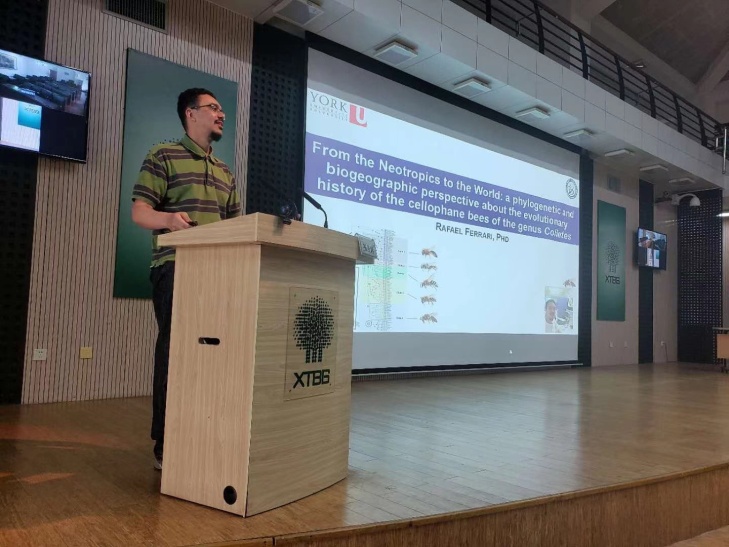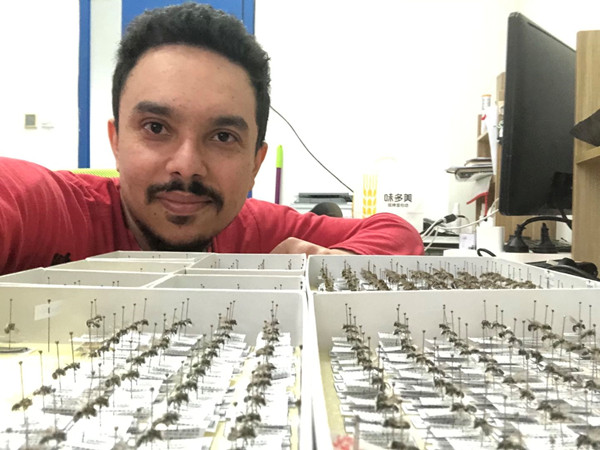


My name is Rafael Ferrari and I am a melittologist. I study the various aspects of the natural world of wild bees. Over the past 15 years, I have spent countless hours looking at preserved bee specimens under a microscope, with the primary goal of trying to understand how diverse they really are and what makes them so special among plant pollinators. But to be able to conduct my research in a laboratory, I first need to go to field to find and capture bees, usually while they are collecting resources (mainly nectar and pollen) from flowers. Working with a group of plasterer bees of the genus Colletes, I have had the opportunity to conduct fieldwork in many different regions while searching for species not found elsewhere. This includes the Atacama Desert, Caribbean, North American Southwest and European Mediterranean. Prior to the President’s International Fellowship Initiative (PIFI), I had never had the opportunity to travel to Asia and, more importantly, to research the unique and magnificent fauna of plasterer bees found there. Once I first heard of the PIFI initiative in August 2019, I immediately realized that was the perfect postdoctoral experience to advance my academic career. I then decided to apply and came up with quite an ambitious research project, including several long field trips across China.

A research initiative led by my supervisor Professor Zhu Chaodong had been conducting annual collection expeditions started in 2014 to Southwest China’s Xizang Autonomous Region to study the Tibetan bee fauna under a multidisciplinary approach. Among the obtained material, I found an impressive number of Colletes specimens, many of them captured in inhospitable areas where very little sampling has historically been performed. A more careful morphological study under a microscope revealed a total of 26 different species of the genus that are now known to occur there. This includes two species (C. bischoffi and C. packeri) that had originally been described by neighboring countries (Bhutan and Thailand, respectively) and another species previously unknown to science: C. splendidus. The specific epithet makes reference to the magnificent, bright-brown hairs that cover most of the species’ body. These and other interesting findings regarding Tibetan Colletes were published in a 72-page monograph that appeared in the Vol. 5,022 issue of the journal Zootaxa in August 2021.

In the summer of 2020, within a two-month period, I visited four environmentally-protected areas in Beijing. On a particular occasion, it came as a big and pleasant surprise that I was able to collect individuals of two different species (C. alini and C. jankowskyi) at the Beijing Olympic Forest Park. Though the largest green space of Beijing (about seven km2), the Olympic Park is completely surrounded by a highly-urbanized environment in the heart of the country’s capital. The DNA data that I obtained from sequencing these bees will be invaluable for a nigh-finished evolutionary study of Colletes that a few collaborators and I have been working on for a few years now. Therein, we can demonstrate that the genus most likely originated in South America, then invaded North America by crossing the Isthmus of Panama and finally colonized Eurasia via the Bering Land bridge about 25 million years ago. Another successful field work of mine in Beijing took place in Xishan National Forest Park, where I managed to not only capture individuals of a third species (C. collaris) but also to bring them alive back to the laboratory. This was done to minimize DNA degradation so that the samples could be used for whole-genome sequencing. In fact, the manuscript in which the whole genome of C. collaris is provided for the first time was submitted to the journal GigaScience in December 2022, and is currently under peer review.
Therefore, I would consider my short stay in China as a success story in my academic life.
Source: Rafael Ferrari,
Institute of Zoology,
Chinese Academy of Sciences